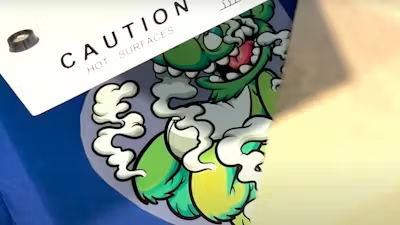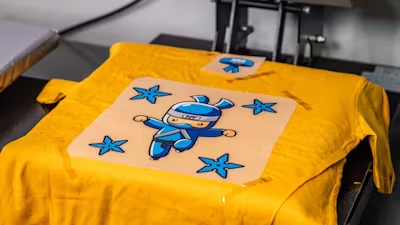You've got the DTF transfer, you've got the blank, and you're ready to create some custom apparel magic. But wait-there's a zipper running right through your print area. Or maybe it's a row of buttons throwing off your game. Don't let these obstacles derail your project. Whether you're personalizing polos for a corporate event, customizing hoodies for your clothing line, or adding flair to button-up baseball jerseys, this guide will equip you with pro-level techniques to handle these tricky garments like a seasoned expert.
We've tapped into our wealth of industry experience to bring you practical, time-saving tips and essential supplies that will elevate your heat-pressing game. So roll up your sleeves-it's time to turn those pressing problems into picture-perfect results.
What you need
- Heat press machine: A good heat press is the primary recommended tool for applying transfers. A Cricut or home iron can work for smaller projects and can be handy for dealing with buttons and zippers.
- Heat press pillows: Various sizes to create even surfaces over protruding elements.
- Garment protector pad: Shields your garment from direct heat and provides extra padding.
- Thermal heat tape: Secures transfers in place during positioning.
- Protective guard sheets: Prevents direct contact between the heat press and garment (parchment paper, craft paper, or butcher paper can substitute).
- DTF transfers: Your custom designs printed on film and ready for application.
- Blank garments: The canvas for your creations.
- Ruler and cutting mat: For precise measurements and safe cutting.
- Exacto Knife or sharp scissors: To modify transfers when necessary.

First option: Isolate the print area
When dealing with zippers, buttons, or seams, your primary goal is to create a flat surface for even heat distribution. The most straightforward approach is to isolate your print area:
- Hang protruding elements off the platen: Position your garment so that zippers, buttons, or bulky seams hang off the edge of your heat press platen. This technique provides a smooth, flat surface for pressing. However, it's not always possible due to garment size, heat press dimensions, or design location. Make sure to reference our DTF transfer placement guide.
- Utilize smaller platens: If you have access to smaller platens, like those for sleeves or hats, use them to your advantage. Thread the section you want to print over the smaller platen, allowing problematic areas to hang freely. This method works wonders for targeted areas like left chest prints on polo shirts.
- Try mini presses or irons: For intricate jobs, consider using a mini Cricut press or even a household iron. These tools allow for precise application in small areas, making them ideal for navigating around buttons or zippers. For instance, you can easily press a left chest design on a polo shirt without interfering with the button placket.

Second option: Heat pressing over all
When you can't avoid pressing over buttons, zippers, or seams, don't worry. By creating an even surface, you can still achieve great results. These are the main principles of heat press success.
- Heat press pillows are your secret weapon for pressing over protruding elements. These versatile tools help create a flat surface and ensure even heat distribution across your transfer area. You can even stack multiple pillows and different sizes to accommodate various garment features. Place pillows between fabric layers, allowing buttons or zippers to sink into the soft surface. Experiment with pillow placement to find the optimal setup for each unique garment.
- Adjust pressure settings: When using pillows or pressing over uneven surfaces, it's crucial to fine-tune your heat press pressure. Start with less pressure than you'd use for a flat garment. Gradually increase the pressure until you achieve even contact across the entire transfer area. Always test your setup on a sample garment before starting a production run.
- Use a garment protector pad: A silicone garment protector pad adds an extra layer of protection. Place it over your transfer and garment before closing the heat press. It helps distribute heat evenly and prevents direct contact between the press and any protruding elements. These pads are especially useful when combined with heat press pillows for maximum protection and even pressure.

Tips for heat pressing garments with zippers, buttons, and seams
Now that we've covered the basic approaches let's go over some specific techniques for common garment types. These tips will help you navigate the unique challenges presented by various apparel styles, ensuring professional results every time.
Polo shirts and quarter zips
Polo shirts remain a staple for workwear and uniforms, while quarter-zip long sleeves are gaining popularity for corporate casual and promotional items. When working with these garments, your primary goal is to create a flat surface for printing.
- For left chest and full back prints, try to position the garment so the button or zipper area hangs off the edge of the platen. It's best to pre-tape your transfer on a nearby table to nail the exact print location. This allows you to focus on positioning the garment on the press without worrying about transfer placement.
- When you can't avoid pressing over the placket, insert a heat press pillow between the fabric layers, directly under the print area. This elevates the print surface and allows buttons or zippers to sink into the pillow. Remember to adjust your heat press pressure to account for the added thickness.

Button-up shirts and full zips
- Button-up baseball jerseys and full-zip hoodies often require designs that span across closures. Start by laying out the garment on a flat surface and positioning your transfer where desired. Mark the top and bottom of the transfer film where it intersects with the placket or zipper. Using a ruler and cutting mat, carefully cut the transfer film in half at your marks with an exacto knife.
- Next, reposition both halves of the design, leaving a small gap for the zipper or shirt placket. For button-ups, unbutton the shirt and lay the placket over the buttons. Secure both halves with thermal heat tape. You might want to tape down the shirt placket as well to keep everything in place during pressing.
- When you're ready to press, place a large heat press pillow (or two) between the fabric layers. Ensure the entire design is completely under the top platen, and adjust your heat press pressure to account for the added thickness from the pillow(s). Then press like normal.
- For button-up jerseys, peel the carrier film away in the same direction as the shirt placket to maintain positioning for the second press. If your design covers buttonholes, you'll need to cut through them with an exacto knife after pressing to ensure the shirt can still be buttoned.
- Alternative full-zip technique: Many blank hoodies now feature a small fabric lip on both sides of the zipper, which can be helpful for full-front designs. With these, you can press the whole design over the zipper initially. After peeling the carrier film but before the second press, carefully cut along the zipper. For the second press, unzip the hoodie while keeping everything else in place. This ensures the best seal right up to the zipper cover.
Garments with protruding seams
- If you can't thread them over a smaller platen to isolate the print area, try the off-the-edge technique. Position the garment so seams or pockets hang off the edge of the platen. This creates a flat surface for your transfer without the need for additional tools. It's a simple solution that works well for many garment types.
- For unavoidable seams or pockets, heat press pillows are your best ally. Choose a pillow slightly larger than your print area and insert it between fabric layers, directly under the print area. This elevates the print surface and allows seams or pockets to sink into the pillow, creating an even pressing surface.
- Combine your heat press pillow with a garment protector pad for optimal results. This combination provides even pressure distribution and protects your garment from direct heat. It's particularly useful when working with delicate fabrics or intricate designs.
- For minor protrusions like collar seams or subtle pocket edges, try the parchment paper hack. Fold multiple sheets together and insert them under your print area. This creates a custom-shaped "pillow" that can accommodate unique garment features without the bulk of a full heat press pillow.

More pro tips for pressing garments with zippers, buttons, and seams
- Mousepads offer a versatile alternative to heat press pillows. Cut them down to a left chest or sleeve size for targeted elevation of your print area above buttons, zippers, or seams. Buying mousepads in bulk provides a dependable addition to your production toolkit, giving you a range of sizes to work with for different garment challenges.
- For larger print areas, dense foam sheets are your go-to solution. Opt for harder foam about ½ inch thick rather than spongy craft foam. Cut these sheets to size, round the corners, and label them by print size for easy identification. This creates a perfect elevated surface for pressing over zippers or buttons on items like hoodies.
- Take your heat pressing game to the next level by creating a custom lower platen pad. Use foam sheets to craft the perfect platen for specific uses, such as full zip hoodies. Cut a groove down the center of the foam for the zipper to sink into, providing a nice flat surface for your print while accommodating the garment's features.
- Use multiple pressings. One of the great advantages of DTF transfers is their ability to withstand multiple pressings without issue. This flexibility allows you to press designs in stages. First, apply the whole design, then target specific areas for touch-ups. Just be careful to avoid scorching the fabric with excessive heat exposure.
- Keep a generous supply of parchment, craft, or butcher paper on hand. Its versatility is unmatched. Fold multiple sheets to create custom-shaped pillows for unique garments or print locations. It's particularly useful for covering minor protrusions like seams under sleeve prints or shirt collars, ensuring a smooth print surface.
- Before starting any production run, take the time to figure out your technique and prepare thoroughly. Have all your settings correct and tools in place before you begin. This preparation prevents the need for on-the-fly adjustments, helping maintain consistency throughout your production and saving valuable time.

Conquering garment challenges for successful DTF prints
Mastering the art of heat-pressing garments with zippers, buttons, and seams opens up a world of possibilities for your custom apparel business. By applying these techniques and tips, you'll be able to tackle even the most challenging projects with confidence. Remember, the key is creating a flat, even surface for your transfers while protecting the garment's unique features.
As you refine your skills, don't be afraid to experiment and find what works best for your specific needs. Ninja Transfers is here to support your creative journey with high-quality DTF transfers, essential supplies, and premium blank apparel from Ninja Blanks. Together, we'll help you achieve your custom apparel goals and impress your clients with flawless, professional results.








































